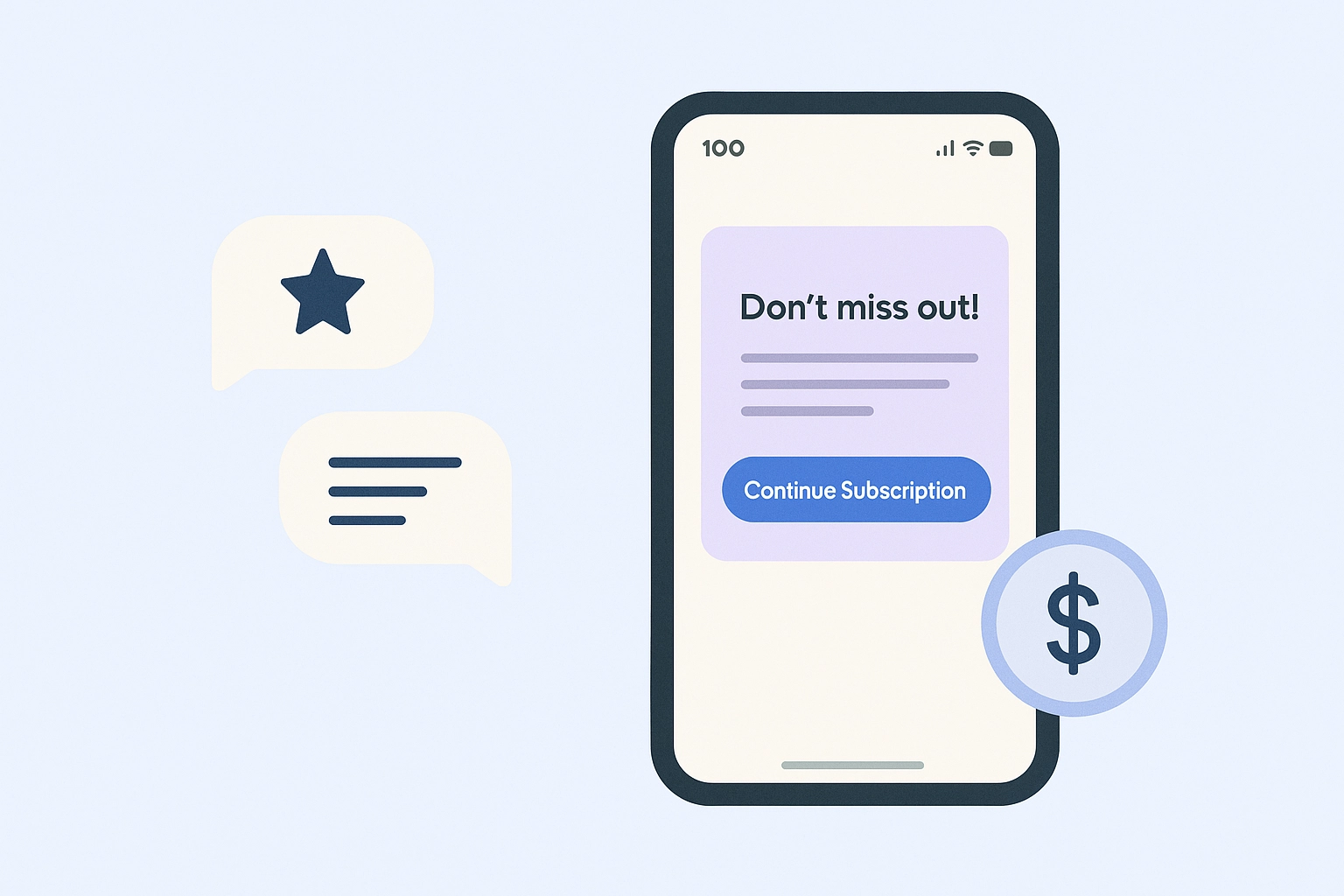How to Find App Ideas That Solve Real Problems (and Validate Them Fast)
Published 5th August, 2025 by Claire McGregor Every day, thousands of new apps hit the market and most quietly disappear. Not because they weren’t clever or well-designed, but because they didn’t solve a real problem. In a world saturated with apps, from fitness trackers to food delivery services, finding a truly valuable app idea can feel like searching for a needle in a digital haystack. This guide walks you through shifting your focus from products to problems, uncovering everyday pain points, and validating your solutions before building.
Every day, thousands of new apps hit the market and most quietly disappear. Not because they weren’t clever or well-designed, but because they didn’t solve a real problem. In a world saturated with apps, from fitness trackers to food delivery services, finding a truly valuable app idea can feel like searching for a needle in a digital haystack. This guide walks you through shifting your focus from products to problems, uncovering everyday pain points, and validating your solutions before building. In this overview you'll learn:
- Why App Ideas Should Start with Real Problems
- Everyday Problems are Opportunities
- 5 Proven Methods to Find Problems
- What Makes a Problem Worth Solving?
- How to Validate Your App Idea Before You Build
- Final Thought: Focus on Problems, Not Products
Want to level-up your app store review analysis?
Try Appbot free now, no credit card needed →Why App Ideas Should Start with Real Problems
Problems reveal needs and when you solve a real need you create real value.
Features ≠ needs
Many people begin with “wouldn’t it be cool if…” ideas. But features without a purpose often lead to apps nobody needs. Building without a clear problem in mind leads to bloated products, vague audiences, and wasted time.
Problems = Pain + Demand
When people experience a problem, they’re motivated to find a solution. If your idea solves that pain, they’re more likely to adopt it, pay for it, and tell others about it.
Based in reality
Problem-based ideas are grounded in real-world experience, not guesses or trends. That means:
- You’re not just making something cool, you’re making something useful.
- You’re less likely to waste time building features no one needs.
Problems help you stay focused
When you build to solve a specific problem, you naturally:
- Know who your users are,
- Know what success looks like, and
- Can prioritize features around one clear goal.
This makes product development faster, leaner, and more user-centered.
Problems Lead to Innovation
Constraints fuel creativity. Trying to fix something broken forces you to think differently, challenge assumptions, and find new approaches.
Everyday Problems are Opportunities
The best ideas solve everyday problems, because people care more about relief than novelty. If you start with a problem, everything else, design, users, growth, comes naturally.
The bigger or more widespread the problem, the bigger the opportunity for impact (and sometimes profit). That’s why companies that solve universal or deeply frustrating problems often grow the fastest.
5 Proven Methods to Find Problems
The best app development ideas don’t start with brainstorming — they start with noticing everyday user pain points. When you learn to spot everyday problems, you uncover hidden opportunities to build something people truly need.
1. Start with Your Own Frustrations
The best place to look for problems is your own life. What slows you down? What annoys you every day? Maybe you can never find a quiet café to work in. Maybe organizing your digital files on your tablet is a nightmare. These aren’t just minor issues, they’re opportunities.
Example: At Tiny Ideas we built Fortify after I was diagnosed with osteoporosis at 41 and warned I was at risk of type 2 diabetes. There are countless fitness and weight lifting apps out there, but none met the needs of women over 40, so we built a science-backed strength training app to improve bone density, build muscle, and support long-term health.
2. Observe Others’ Pain Points
Watch how people behave. Ask questions. What are they struggling with? What are they doing in a roundabout or inefficient way?
- Ask friends and colleagues what their biggest daily annoyances are.
- Hang out in online forums (like Reddit or Quora) and look for repeated complaints.
- Look at app reviews; what are users saying is missing or broken?
Example: Calendly came from observing how painful scheduling meetings was for everyone. Instead of dozens of back-and-forth emails, one simple app solved it.
3. Reimagine Outdated Solutions
There are entire industries still operating on paper, outdated spreadsheets, or legacy software. These are ripe for disruption. Think: healthcare, education, government, logistics.
Example: DocuSign took the ancient practice of signing papers and brought it into the digital age, making remote contracts simple and secure.
4. Look for “Frankenstein” Solutions
Any time someone says, “I just use a combination of sticky notes, voice memos, and emailing myself,” they’re telling you there’s no good app for what they need. These solutions often point to a real, unsolved problem, one that a well-designed app could fix elegantly.
Not all problems are created equal. Look for problems that:
- Happen frequently (daily or weekly),
- Have a high emotional charge (frustration, anxiety, embarrassment), or
- Affect lots of people.
An app that relieves daily stress or saves people time will always have value.
Example: Notion came from observing how people were juggling multiple tools for notes, tasks, documents, and projects and combining them all into one customizable workspace.
5. Find Jobs-to-be-done (JTBD)
Instead of thinking in terms of features, think about the job your app is being “hired” to do.
Ask: What job is this user trying to get done, and how can I help them do it better?
Example: A weather app isn’t just showing the forecast, it helps people decide what to wear or plan their day.
What Makes a Problem Worth Solving?
Not all problems are created equal. Look for problems that:
- Is the problem frequent or recurring?
- Does it trigger emotion (stress, embarrassment, frustration)?
- Have people tried DIY solutions?
- Is the audience large enough or underserved?
- Would solving this problem save time, money, or stress?
How to Validate Your App Idea Before You Build
Before you build anything, validate that the problem is real and painful; this is the foundation of successful app idea validation.
Here’s how to validate your app idea:
- Check out the App Stores. What’s already out there? How are similar apps positioned?
- Dig into app reviews. Look for patterns in complaints, feature requests, or unmet expectations. What's missing, clunky or frustrating? These are gold mines for insights.
- Talk to 5–10 people who experience the problem. Ask what they’re doing now to deal with it. Are they frustrated? Have they tried fixing it?
- Sketch a prototype. Don’t wait until it’s perfect, even a rough one, so you can get early feedback.
- Test demand. Create a simple landing page and email waitlist. See if people are interested enough to sign up.
Validating early saves time, money, and energy and helps ensure you’re building something people actually want.
Final Thought: Focus on Problems, Not Products
App ideas rooted in real problems are more likely to stick. They solve genuine pain points, which means they’ll be useful, and people will want to use them. So the next time you’re stuck brainstorming, stop asking, “What app should I make?” and start asking, “What problem can I solve?”. You don’t need to invent something revolutionary. You just need to solve something real. Start there and the rest will follow.
Want to level-up your app store review analysis?
Try Appbot free now, no credit card needed →Where to from here?
- Learn how to improve app reviews and skyrocket your app's success.
- Level up your app's reputation with proven strategies to get better reviews from satisfied users.
- Streamline your app review management process and take control of your app's feedback loop.
- Explore the world of addictive apps and learn how to create irresistible experiences for your users.
- Stay informed and in control of your app's reputation with Appbot's comprehensive app review monitoring tool.
About The Author

Claire is the Co-founder & Co-CEO of Appbot. Claire has been a product manager and marketer of digital products, from mobile apps to e-commerce sites and SaaS products for the past 15 years. She's led marketing teams to build multi-million dollar revenues and is passionate about growth and conversion optimization. Claire loves to work directly with the world's top app companies delivering tools to help them improve their apps. You can connect with her on LinkedIn.
Enjoying the read? You may also like these
 Win Back App Subscribers: How to Use Apple’s Retention Messaging API to Reduce Churn
Win Back App Subscribers: How to Use Apple’s Retention Messaging API to Reduce Churn Learn how Apple’s new Retention Messaging API helps reduce app subscription churn with personalized, in-the-moment messages. Backed by research, this guide shows how to combine App Store feedback, discounts, and smart messaging to boost retention.
Discover what’s driving the explosive growth of mobile gaming in 2025. Explore key trends, revenue forecasts, and strategies developers are using to succeed in a competitive market.
Excellence in app store review management is key when it comes to making apps more useful, beautiful & profitable. See our tips to manage reviews effectively.
Naming an app is HARD. Read about the big mistake we made and how to avoid it.


